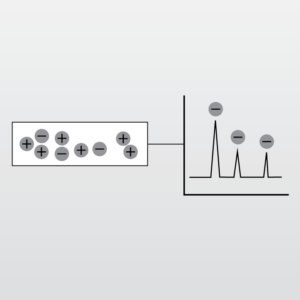Ion Chromatography (IC)
Home » Our Techniques » Chromatography » IC
Ion Chromatography (IC) is a high-throughput and versatile technique for analytical laboratories and may be set up to analyze either positive or negative ions. Similar to HPLC, IC utilizes an ion’s intrinsic affinity for both an “eluent” (typically buffered water) and a “stationary phase” (porous solid support with charge-bearing functional groups).
Essentially, a pump is used to provide a continuous flow of a solvent into which a dissolved sample is introduced. Once the sample is in the solvent flow, it travels through an analytical column. The ions present in the sample mixture are then separated depending on their affinity to the column. After the components in the sample are separated, they pass through a conductivity detector. The detector response and the “retention time” (time it takes for a compound to pass from the injector to the detector) of the ion(s) of interest may then be compared to a reference material. The conductivity detector can detect organic and/or inorganic ions (either positive or negative) and may be customized to focus on a particular client needs.

Ideal Uses of IC
- Medical device chemical characterization via ISO 10993:18
- Food and beverage analysis
- Aqueous samples (e.g. water) or water-extractable surfaces
- More involved and specialized sample preparation is available for a broad variety of sample matrices; please inquire
- Separation and purification of charged molecules
- Quality assurance and control
- Sample purity determination
- Quantitative analysis of ions
- Common cations
- Lithium, sodium, ammonium, potassium, magnesium and calcium
- Common anions
- Fluoride, chloride, nitrite, nitrate, sulfate, bromide and phosphate
- Other ion examples
- Some secondary amines (e.g. diethylamine), chlorate, chlorite, sulfite (as sulfate), acetate, formate, iodide, citrate, bromate
- Common cations
Strengths
- Rapid determination of inorganic and organic anions and cations
- Sensitivity on the µg/L (ppb) level
- High selectivity in samples with complex matrix
- Ion species analysis
- Stability of the separator columns
- Small sample quantity needed
Limitations
- Only ionic analytes
- Identification of peaks is based on a retention time match to a standard solution
- Buffer requirement
- Small changes in pH can greatly alter binding profile of stationary phase and ion states
- Sample must be applied to the ion chromatography support under conditions of low ionic strength and controlled pH
- Chromatographic instrumentation should be resistant to salt-induced corrosion
IC Technical Specifications
- Thermo Scientific Dionex ICS 3000 and 5000, equipped with conductivity detectors (CD)
- pH Range: pH 2 – 12
- Minimum Sample Volume: 1500 µL (2000 µL recommended)
- Control Software: Chromeleon software version 6.8
Would you like to learn more about using Ion Chromatography (IC)?
Contact us today for your Ion Chromatography (IC) needs. Please complete the form below to have an EAG expert contact you.